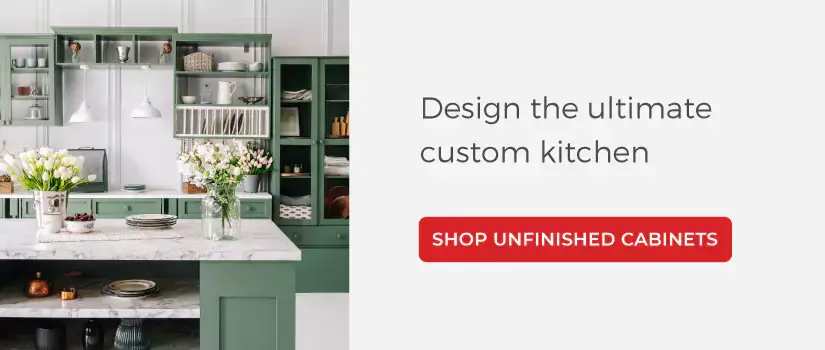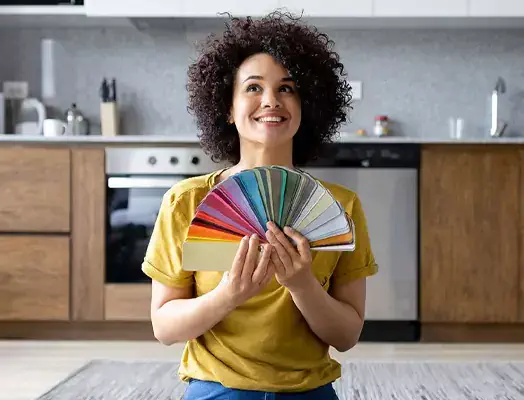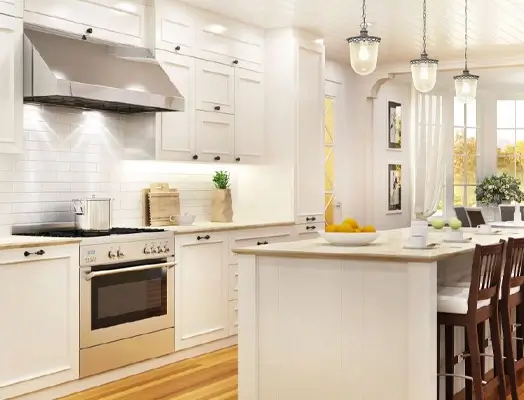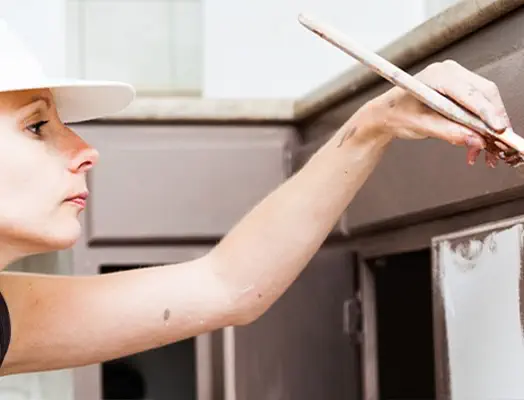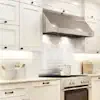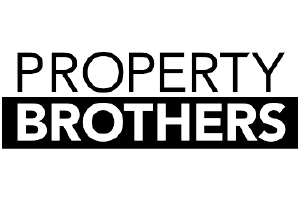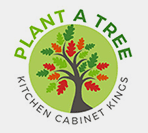Unfinished Cabinets Guide: Customization, Savings, and Creative Possibilities

Unfinished cabinets open up a world of design possibilities for your kitchen. These blank wood canvases offer a unique opportunity to create something truly personal. Unlike finished cabinets, unfinished cabinets arrive without paint, stain, or sealant, leaving the creative door wide open.
In this guide, we'll explore the pros and cons of unfinished cabinets, how to add finish to your unfinished cabinets, types of cabinet finishes, and ideas to make them beautifully complement your ideal aesthetic.
Already sold on unfinished cabinets? Browse our selection of high-quality raw wood cabinets to bring your unique kitchen design to life.
What Are Unfinished Cabinets?
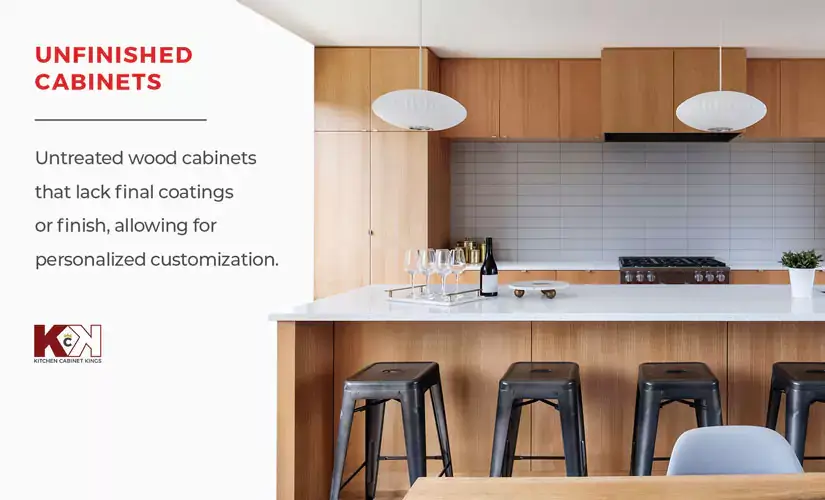
Unfinished cabinets are raw, unaltered wooden cabinets that provide a perfect canvas for customization. Unlike pre-finished cabinets, which come with a coat of paint, stain, or sealant, unfinished cabinets arrive in their natural state. This means they lack the final touches that define their appearance, allowing homeowners and contractors to personalize them according to their design preferences.
Pros and Cons of Unfinished Cabinets
Unfinished cabinets are a top choice for homeowners looking to save money on their kitchen cabinets while providing the unique opportunity for a one-of-a-kind design. However, unfinished wood cabinets are not without their challenges.
Whether you're a DIY enthusiast or a contractor looking to strike the perfect balance between aesthetic and practicality, understanding the pros and cons of unfinished cabinets can help you determine whether they're best suited for your project.
Pros:
 Customization: Unfinished kitchen cabinets provide a blank slate for self-expression, so you can select the perfect cabinet paint color, stain, or finish that resonates with your unique style and kitchen theme.
Customization: Unfinished kitchen cabinets provide a blank slate for self-expression, so you can select the perfect cabinet paint color, stain, or finish that resonates with your unique style and kitchen theme. Cost savings: Since unfinished wood cabinets require less labor and fewer materials, expect to save between 10% and 30% compared to the cost of pre-finished cabinets.
Cost savings: Since unfinished wood cabinets require less labor and fewer materials, expect to save between 10% and 30% compared to the cost of pre-finished cabinets. Personalization: For DIY enthusiasts and creative minds, the prospect of finishing cabinets yourself offers a hands-on project to personalize and elevate your living spaces.
Personalization: For DIY enthusiasts and creative minds, the prospect of finishing cabinets yourself offers a hands-on project to personalize and elevate your living spaces. Matching decor: Unfinished cabinets can be tailored to match existing decor elements to create a cohesive and harmonious aesthetic throughout the kitchen.
Matching decor: Unfinished cabinets can be tailored to match existing decor elements to create a cohesive and harmonious aesthetic throughout the kitchen. Quality control: Since the wood cabinet core is exposed, you can assess the raw material's quality and craftsmanship before applying your chosen finish to ensure the longevity of your cabinets.
Quality control: Since the wood cabinet core is exposed, you can assess the raw material's quality and craftsmanship before applying your chosen finish to ensure the longevity of your cabinets. Project flexibility: Raw wood cabinets allow you to experiment with various staining, painting, and sealing techniques that can result in a unique, one-of-a-kind design.
Project flexibility: Raw wood cabinets allow you to experiment with various staining, painting, and sealing techniques that can result in a unique, one-of-a-kind design.
Cons:
 Labor and skill: The finishing process demands a certain level of expertise; improper finishing can lead to suboptimal results that may need to be fixed by a professional.
Labor and skill: The finishing process demands a certain level of expertise; improper finishing can lead to suboptimal results that may need to be fixed by a professional. Time investment: Finishing cabinets can be time-consuming, which might be a concern if you're looking for quick results in your kitchen renovation.
Time investment: Finishing cabinets can be time-consuming, which might be a concern if you're looking for quick results in your kitchen renovation. Inconsistent finish: If you're inexperienced with painting or staining, you may encounter challenges in achieving a uniform finish.
Inconsistent finish: If you're inexperienced with painting or staining, you may encounter challenges in achieving a uniform finish. Durability concerns: Proper sealing is crucial to ensure cabinets withstand daily wear, which may add even more pressure to the finishing process.
Durability concerns: Proper sealing is crucial to ensure cabinets withstand daily wear, which may add even more pressure to the finishing process. Limited options: While unfinished cabinets offer customization, achieving specific finishes requires extra effort and may limit your immediate choices.
Limited options: While unfinished cabinets offer customization, achieving specific finishes requires extra effort and may limit your immediate choices.
8 Unfinished Cabinet Ideas
From eye-catching paint colors to subtle patterns and textures, there are countless ways to reflect your creativity and personal taste with unfinished wood cabinets. Here are a few ideas to inspire your custom cabinet project.
1. Staining Techniques
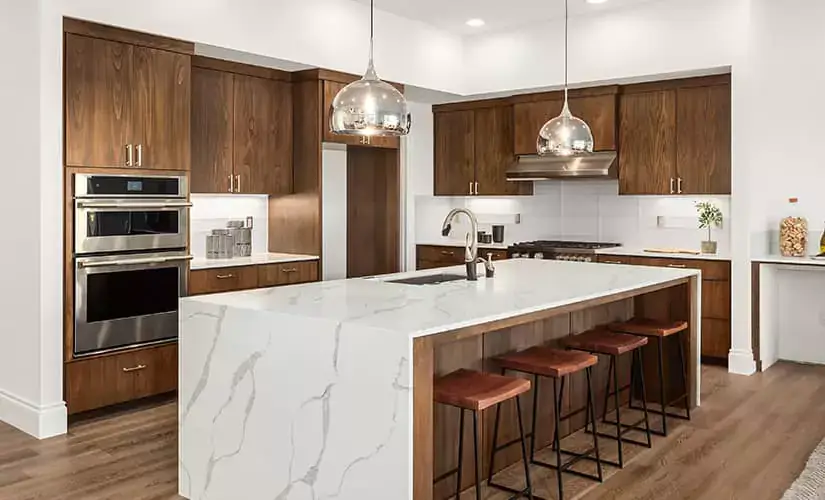
Staining unfinished cabinets allows you to change the color of your cabinets without hiding the beautiful wood grain underneath. There are four methods to staining kitchen cabinets:
- Traditional staining: Apply traditional wood stain directly to the cabinet surfaces, allowing it to penetrate the wood and highlight its natural grain patterns.
- Gel stains: Gel stains are thicker than traditional liquid stains, making them easier to apply. They provide a more even finish, which is beneficial for achieving consistent color on various wood types.
- Layered staining: Layering different stain colors can create a unique and multidimensional look. For example, you can start with a lighter base stain and then apply a darker stain for accents.
- Wiping stains: These stains are applied and then wiped off, allowing you to control the intensity of the color. This method is great for achieving a balanced, even tone.
Keep in mind that the type of wood you're staining will influence how the stain color appears. It's advisable to test stains on a small inconspicuous area of the wood before committing to the entire cabinet.
2. Painting Possibilities
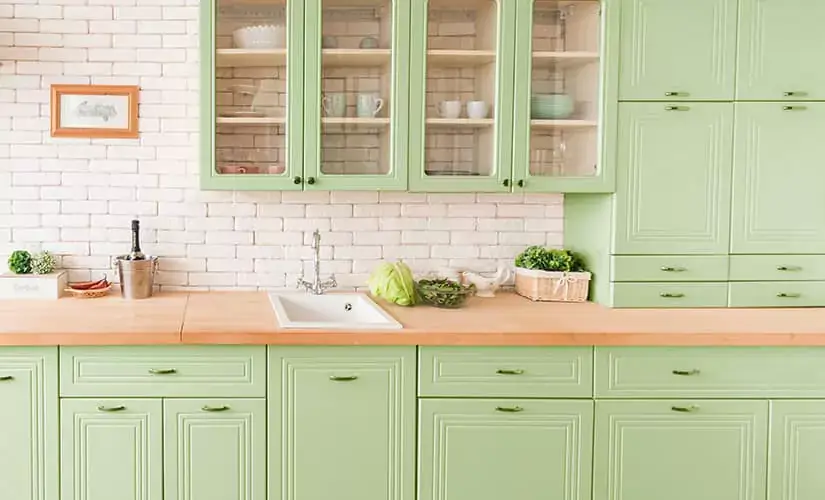
Embracing creative paint ideas and color combinations can be a game-changer in your kitchen's design narrative. Painting unfinished cabinets allows you to infuse vibrant personality or subtle elegance into your space.
Here are a few suggestions based on trending kitchen color schemes:
- Timeless neutrals: White and cream cabinets offer a classic and versatile backdrop that suits various design styles, from traditional to modern.
- Rustic charm: Achieve a vintage look with distressed finishes in shades like antique blue, sage green, or weathered gray.
- Bold statements: Opt for deep, rich hues like navy blue or forest green to bring sophistication and depth to your kitchen.
- Soft pastels: Create an open, airy atmosphere with pastel shades such as pale mint, soft blush, or light aqua.
- Urban elegance: Embrace sleek modernity with shades of gray paired with metallic accents, adding an urban touch to your kitchen.
- Subtle tones: Choose subtle shades like muted teal or dusty rose for a sophisticated and understated ambiance.
- Contrasting colors: Make a statement by combining light and dark shades, creating a captivating contrast that draws attention to your cabinets.
- Monochromatic shades: Stick to a single color family but vary the tones to achieve a trendy monochromatic effect.
3. Hardware Choices

Cabinet hardware plays a pivotal role in shaping the overall appearance of unfinished cabinets. These seemingly small details can significantly impact the cabinet's style, functionality, and overall ambiance of your kitchen.
Your choice of cabinet hardware can drastically alter the cabinet's aesthetic. Sleek, modern hardware adds a contemporary touch, while ornate knobs evoke a traditional vibe. Consider the finish of the hardware - mirrored chrome for a polished look, antique brass for vintage charm, or matte black for a modern edge.
4. Distressed Finishes
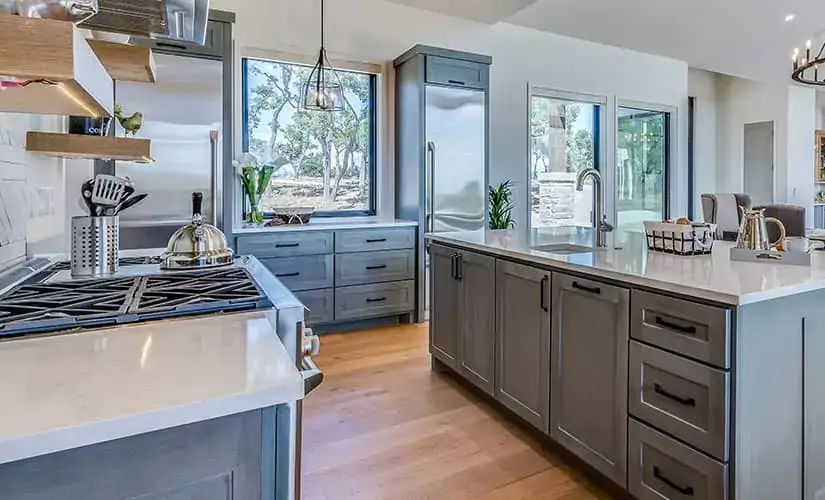
Distressed finishes are a timeless technique that can imbue unfinished cabinets with a rich sense of character and history. Intentionally creating a weathered, aged appearance can evoke a sense of nostalgia and authenticity in your kitchen space.
You can get the look by painting your cabinets and gently sanding the edges, corners, and raised surfaces to reveal the bare wood underneath. This creates a faux aged patina that adds depth and dimension to rustic farmhouse or shabby chic kitchens.
5. Two-Tone Designs

Incorporating two-tone kitchen cabinets involves combining different finishes to create a distinctive and visually striking kitchen. This approach allows you to play with contrast, depth, and texture to craft a dynamic and personalized space.
Two-tone designs help harmoniously integrate diverse design elements. For example, pairing light upper cabinets with dark lower ones can create a sense of grounding while maintaining an open, airy feel. Some of our favorite cabinet color combos include:
- Deep navy blue and white
- Matte black and light natural wood
- Varying shades of gray
- Mint green and pale blush
- Dark stained wood and cream
- Forest green and gold
6. Natural Wood
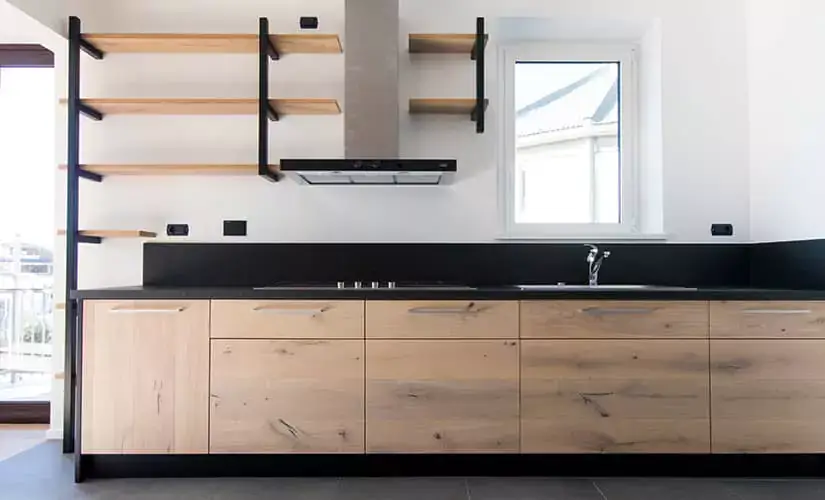
Showcasing the natural wood grain of unfinished cabinets is a design approach that celebrates the inherent beauty of wood. This technique allows the wood's unique patterns, textures, and colors to take center stage, creating an inviting and organic ambiance in your kitchen.
To get the look, all you need to do is seal your cabinets with clear wax to prevent water damage and swelling. You can also add a stain or glaze to your unfinished cabinets to better match your design.
7. Combined Materials
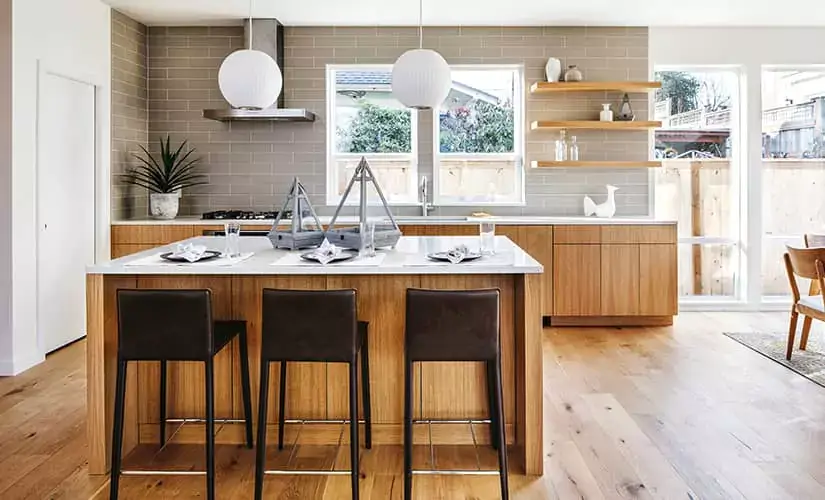
If you choose to embrace the natural wood look, you can create an even more dynamic and multidimensional space by combining complementary materials, like:
- Metal: Combining the warmth of unfinished wood cabinets with sleek metal accents, such as stainless steel or brushed brass hardware, adds a contemporary edge while maintaining a cozy atmosphere.
- Stone: Integrating stone countertops, backsplashes, or flooring with unfinished cabinets balances the natural textures of wood with the solid, cool surfaces of stone.
- Glass: Adding glass inserts to select cabinet doors lends an elegant touch and an opportunity to showcase your favorite dishware.
- Tiles: Incorporating textured tiles in areas like backsplashes or accents can provide a tactile contrast to the smoothness of wood to create a sensory-rich environment.
- Sleek surfaces: Introducing glossy or reflective surfaces, such as mirrored tiles or high-gloss countertops, can play off the rustic charm of unfinished wood for a chic juxtaposition.
- Natural elements: Incorporating elements like natural fibers, plants, or live-edge wood adds a touch of nature that enhances the organic feel of unfinished cabinets.
8. Contrasting Island

Similar to the two-tone effect, using unfinished cabinets for a contrasting kitchen island is gaining momentum in modern kitchens. This approach uses unfinished cabinets specifically for the kitchen island, creating a focal point that stands out against the surrounding finished cabinets.
An unfinished cabinet island brings a bold, eye-catching element to the kitchen. The contrast between the natural wood or unfinished look of the island and the finished cabinets can create a stunning visual impact that doubles as a functional space and centerpiece that anchors the room.
How To Customize Unfinished Cabinets
From surface preparation to selecting the right finishes and ensuring longevity, customizing your unfinished cabinets involves more than just slapping on a coat of paint. We put together a list of essential steps to guide your cabinet finishing process:
- Prep your surface: Start by ensuring the cabinets are clean and free from any dirt or debris. Sand the surfaces using progressively finer grits of sandpaper, starting with a coarser grit to remove any imperfections and gradually moving to a finer grit for a smooth finish. Proper sanding not only creates an even surface for finishing, but also helps the stain or paint adhere effectively.
- Choose the right finish: You can choose stains that enhance the wood grain, paints that match your color scheme, or sealants that offer protection and durability. Ensure the finish you choose complements your kitchen's overall design and suits the wood type.
- Test on scrap: Before applying finishes to your cabinets, it's wise to test them on a piece of scrap wood of the same type or a discrete part of the cabinet. This allows you to gauge how the finish will appear and interact with the wood so you can adjust the application technique and refine your chosen finish if needed.
- Apply the finish: Follow the manufacturer's instructions carefully when applying your cabinet finish. Begin with a smooth, clean surface and apply the stain or paint evenly using brushes, rollers, or sprayers. Ensure uniform coverage, and work in sections to avoid drips or uneven lines. Allow each coat to dry fully before applying the next, and sand lightly between coats for a smoother finish.
- Apply a protective coating: Applying a protective sealant is crucial for preserving the finish and extending the cabinets' lifespan. Whether it's a clear polyurethane for stained cabinets or a clear topcoat for painted ones, proper sealing guards against moisture, stains, and wear.
- Maintain your cabinets: To maintain your cabinet finish, avoid using abrasive cleaners that could damage the surface. Regularly clean your cabinets with a soft cloth and mild soap, wiping up spills promptly. Consider using furniture wax or specialized cabinet cleaners to enhance and protect the finish over time.
If you're unsure about the finishing process, don't hesitate to seek professional help. A finishing expert can guide you in choosing the right finishes, ensuring proper application, and achieving the desired results.
Unfinished Cabinet FAQs
Still curious about unfinished kitchen cabinets? We answered a few of the most frequently asked questions to help you select the best option for your project.
Are unfinished cabinets the same quality as finished ones?
Raw wood cabinets are typically the same quality — or even higher quality — as their finished counterparts since they are made from solid wood and not fabricated materials. In fact, some homeowners prefer them as they allow for a closer inspection of the wood's quality before applying a finish.
Can I change the finish of my unfinished cabinets later on?
Unfinished cabinets offer you the flexibility to change the finish over time. You can refinish your cabinets to match evolving trends or refresh the look of your kitchen without replacing them.
What types of wood are unfinished cabinets made from?
Unfinished cabinets can be made from a wide range of wood species, including oak, maple, cherry, pine, and more. The choice depends on your design preferences, durability requirements, and budget.
From showcasing the natural beauty of wood grain to embracing modern minimalism, unfinished cabinets empower you to craft a space that is uniquely yours. As you embark on your kitchen design journey, don't hesitate to explore various finishing techniques, experiment with colors, and collaborate with design professionals to bring your vision to life.
